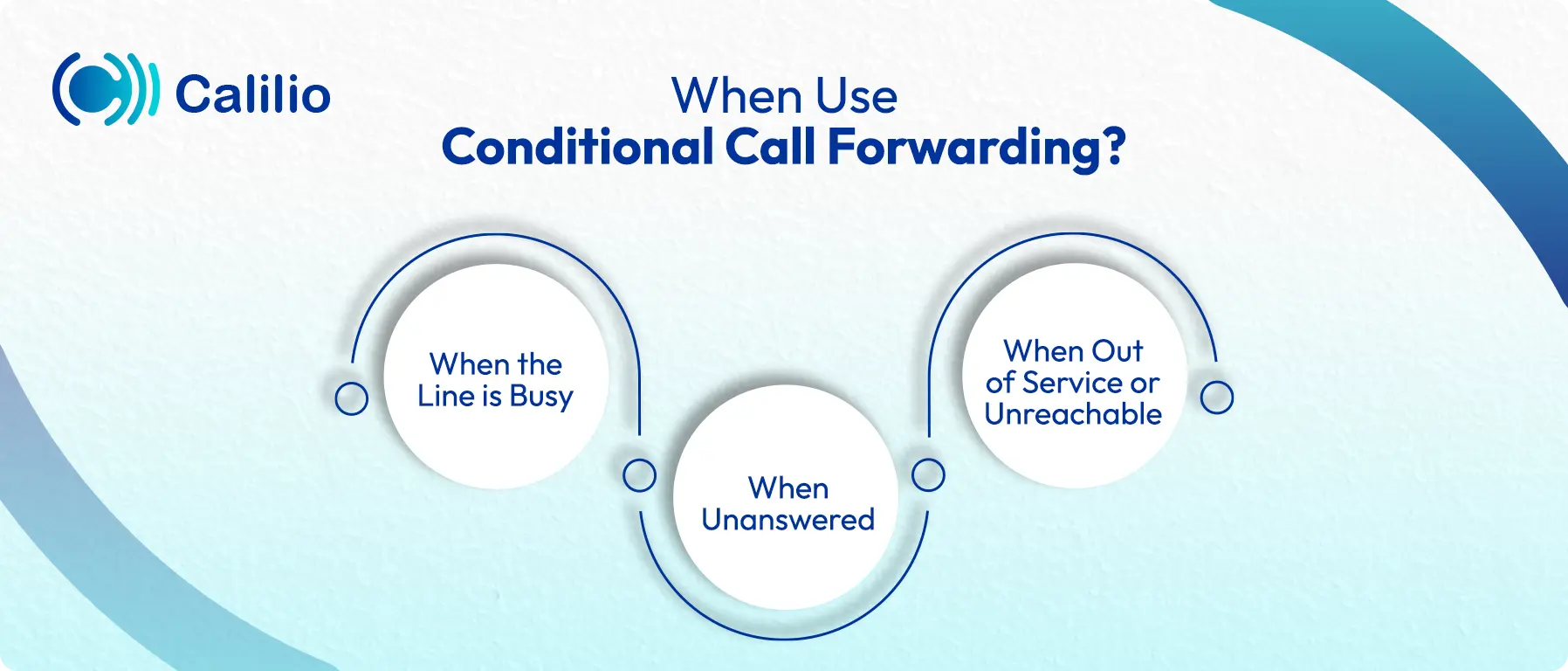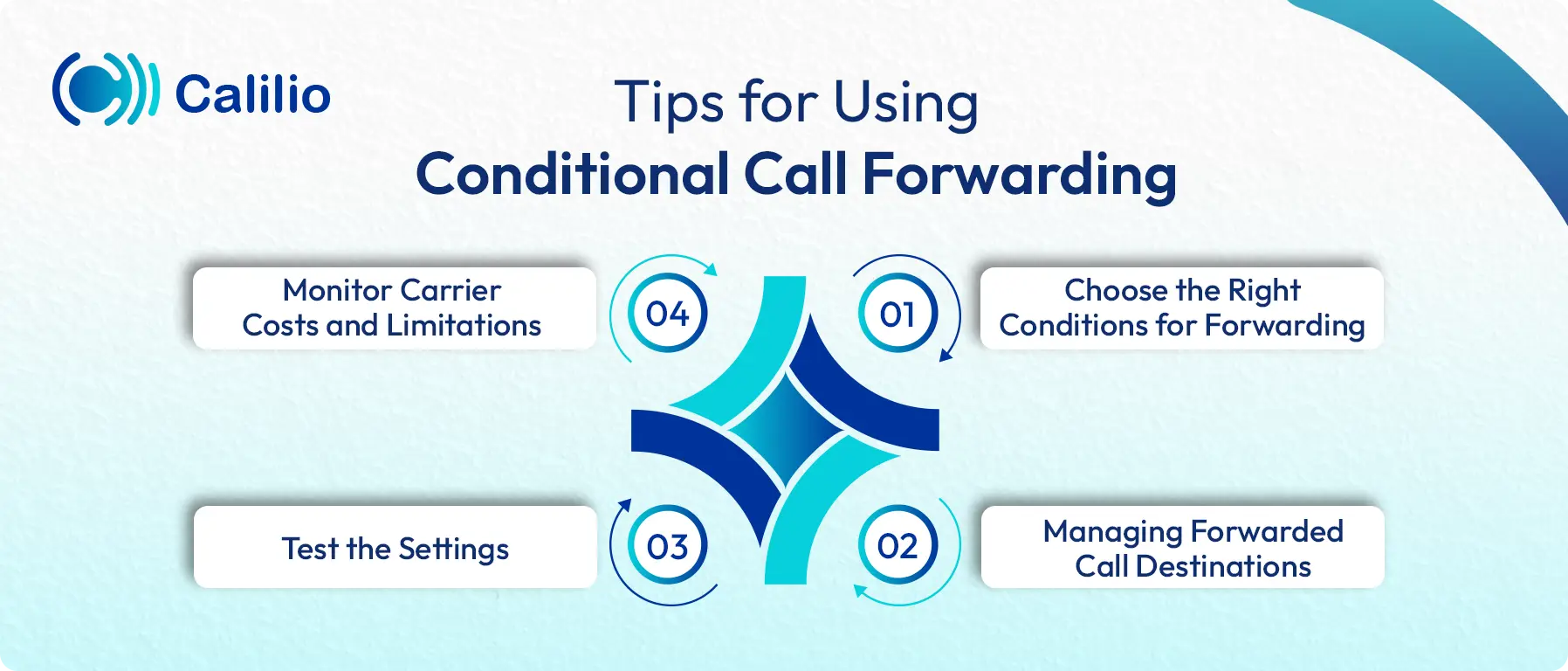How to Set up Conditional Call Forwarding on iPhone and Android?

Missing important calls, whether you’re in a meeting, your phone is off, or someone calls while you’re already on another call, can be frustrating. Relying only on voicemail often isn’t enough, and constantly checking missed calls can disrupt your day.
That’s where conditional call forwarding comes in. This feature automatically redirects calls only when you can’t answer, such as when your phone is busy, unanswered, or out of reach, so you stay connected without having to manually manage every call.
In this article, we’ll show you exactly how to set up conditional call forwarding on both iPhone and Android, helping you ensure important calls always reach you at the right time.
Highlights:
Conditional call forwarding is a phone feature that automatically redirects incoming calls to another number only when your line is busy, unanswered, or unreachable.
You should use conditional call forwarding when you want calls redirected only if your phone is busy, unanswered, or out of reach.
Conditional call forwarding ensures you never miss important calls by redirecting them under specific conditions, offering flexibility, professionalism, and cost-effective connectivity.
On Android, you can enable conditional call forwarding by navigating to Phone app > Settings > Supplementary Services > Call Forwarding, then selecting the desired conditions and entering a forwarding number.
To set up conditional call forwarding on your iPhone, open the Phone app and dial *67*number# for busy calls, *62*number# for unreachable calls, or *61*number# for unanswered calls, then press the call button to activate.
When using conditional call forwarding, set the right conditions based on your availability, test the setup to ensure it works correctly, and check with your carrier for any fees or limitations.
What is Conditional Call Forwarding?
Conditional call forwarding is a telecommunication feature that automatically redirects calls to another number under specific conditions. Instead of forwarding all calls, it only delivers those that meet predetermined criteria, such as when you are busy on another line, or your number is unreachable. It ensures all important calls reach you or a designated recipient while optimizing call management.
When Use Conditional Call Forwarding?
Conditional call forwarding is useful when you are busy on another call, when you don't answer within a certain number of rings, or when your phone is unreachable. This feature ensures that important calls are still answered by redirecting them to another number.

- When the Line is Busy: Use conditional call forwarding to redirect calls to another number while you’re already on a call, so callers don’t get a busy tone or go straight to voicemail.
- When Unanswered: If you’re unable to answer your phone after a certain number of rings, conditional call forwarding can send the call to another device or voicemail.
- When Out of Service or Unreachable: If your phone is turned off, out of range, or in an area with no signal, conditional call forwarding can automatically redirect calls to a secondary phone number.
Benefits of Conditional Call Forwarding
Conditional call forwarding helps you stay available by redirecting calls when your line is busy, unanswered, or unreachable, ensuring you never miss important opportunities. It also adds professionalism, flexibility, and cost-effectiveness by letting you control when and where calls are forwarded without extra phone lines.
- Never Miss a Call: Conditional call forwarding ensures you won’t miss important calls, even when your primary phone is busy, unanswered, or unreachable. By forwarding calls under specific conditions, you can ensure your calls are always answered.
- Maintain a Professional Image: Missed or dropped calls can make a poor impression. Forwarding calls during busy or unreachable times shows professionalism and reliability, especially for business users.
- Reduced Risk of Missed Opportunities: For professionals and business owners, missed calls can result in lost opportunities. Conditional forwarding eliminates this risk by making sure that calls are redirected to a secondary device.
- Flexibility and control: You decide under what conditions calls are forwarded, busy, unanswered, or unreachable, rather than forwarding everything by default. This control lets you balance availability with convenience.
- Cost-Effective: For people with multiple phone numbers or devices, conditional call forwarding offers a cost-effective way to stay connected without needing to invest in additional lines or services.
How to Set Up Conditional Call Forwarding on Android?
On Android, you can set up conditional call forwarding by opening the Phone app, tapping More options, then going to Settings > Supplementary Services > Call Forwarding. From there, choose when to divert calls, such as when busy, unanswered, or unreachable, and enter the number you want calls redirected to.
Here is how to enable call forwarding on Android devices:
- Open the Phone app.
- Tap the More options icon (three dots) in the top-right corner.
- Go to Settings and select Call Forwarding.
- Choose Voice Calls.
- Pick the condition for forwarding:
- Forward when busy.
- Forward when unanswered.
- Forward when unreachable.
- Enter the phone number you want calls to be forwarded to.
- Tap Enable to activate.
To turn off conditional call forwarding, go back to the same menu, select the forwarding option you previously enabled and tap Disable.
How to Set Up Conditional Call Forwarding on iPhone?
To set up conditional call forwarding on iPhone, open the Phone app and dial *67*phone number# for busy line, *62*phone number# for unreachable calls, or *61*phone number# for unanswered calls. Then press the dial button to activate forwarding.
iPhones do not have built-in settings for conditional call forwarding. Instead, availability and setup depend entirely on your mobile carrier.
Here is how to enable call forwarding on iPhones:
- Tap the Phone app on your home screen.
- Enter the appropriate code depending on the condition:
- Busy line: Dial *67*phone number#
- Unreachable (out of service/no signal): Dial *62*phone number#
- Unanswered calls: Dial *61*phone number#
- Press the Call button to activate forwarding for the selected condition.
How to Turn Off Conditional Call Forwarding on iPhone?
To disable conditional call forwarding on iPhone, open the Phone app, dial the code for the condition you want to disable (##61# for unanswered, ##62# for unreachable, or ##67# for busy), press Call, and wait for confirmation.
Here is how to do it:
- Open the Phone app and go to the Dialer.
- Enter the appropriate code based on the condition you want to disable:
- Unanswered calls: Dial ##61#
- Unreachable calls (out of service/no signal): Dial ##62#
- Busy line: Dial ##67#
- Press the Call button and wait for a confirmation beep or a notification that the forwarding has been deactivated.
Tips for Using Conditional Call Forwarding
When using conditional call forwarding, choose the right conditions so your calls are redirected based on your availability and priorities. After setup, test the settings to confirm they work correctly, and review your carrier’s rules and fees to avoid unexpected costs or restrictions.

1. Choose the Right Conditions for Forwarding
Before forwarding the calls, identify the correct scenarios for effective call management. It involves understanding your daily schedule, peak business hours, and when you’re least available. Considering these factors ensures that important calls are rerouted to you or your team at the most convenient moments.
2. Managing Forwarded Call Destinations
Decide whether calls should go to a colleague, another office location, or your mobile device based on who can best address the caller’s needs. Choosing the right person or place for calls to go to means they’re always handled by the best person for the job.
3. Test the Settings
After setting up call forwarding, conduct tests to verify that the conditions work as expected. Make test calls from different numbers and in various scenarios to ensure the correct forwarding of calls. It helps identify any setup issues or adjustments needed, ensuring the system functions smoothly and as intended.
4. Monitor Carrier Costs and Limitations
Some carriers may charge for forwarded calls, especially when forwarding to numbers outside your local area. Check with your provider about potential fees or limitations so you don’t get unexpected charges on your bill.
Conclusion
Conditional call forwarding ensures calls reach you at the right time, making you accessible in various scenarios, whether in a meeting, on the move, or out of the office. It ensures you never miss important conversations, boosting both efficiency and customer satisfaction. You can set conditional call forwarding up through in-built device apps or specific dialing codes, depending on whether it’s an iPhone or Android device.
While most smartphones allow you to set up conditional call forwarding using dial codes or built-in settings, these options are generally limited to simple redirection. For solopreneurs and businesses that deal with higher call volumes or require more flexibility, this basic functionality often falls short.
Frequently Asked Questions
Why does my phone show call forwarding?
Your phone displays 'call forwarding' because you’ve activated a feature that sends incoming calls to another number under certain conditions, like when your line is busy, you don’t answer, or you’re out of coverage.
Why does my phone say call forwarding unconditionally?
What are all conditional calls forwarding?
How do I remove conditional call forwarding?
How do I turn off call forwarding code?
How do I change my call forwarding back to normal?
Is conditional call forwarding safe?

Still have questions?
Can’t find the answer you’re looking for? Please chat with our friendly team.
Stay in the loop
Get the latest call insights, trends, and updates delivered straight to your inbox.
By subscribing, you agree to receive updates from Calilio.
You can unsubscribe anytime.
Phone numbers
Get International Phone Numbers
Singapore
|Australia
|New Zealand
